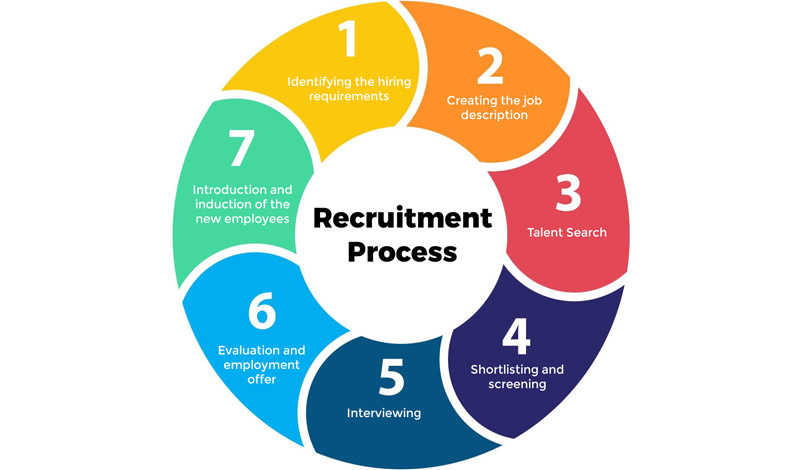Our Five-stage Recruitment Process Explained
As we look into the growth and success of a business organization, we often forget to acknowledge the people behind it.
The praiseworthy success of an organization is majorly contributed by the staff and people. It all comes down to effective recruitment and staffing strategies, that is having the right people at the right time, doing the right things. The hired employees can either turn out to be a liability or an asset to the organization. It all depends on the effectiveness and accuracy of the recruitment process.
Many business leaders and managers admit that a bad hire can slow down the overall success and performance of the business. It not only causes major damage to the business, it affects the overall motivation of the organization.
It is important to ensure effective recruitment & selection process in the organization to hire the best. It requires the correct skill set to implement effective recruitment strategy and fill in the job positions.
What is recruitment and its importance in HR management?
Recruitment can be defined as the process of identifying talent needs, screening potential candidates and hiring talent to fill in a job position. A scientific recruitment process involves job analysis, sourcing and screening candidates, analysing their potential, examining their ability and ends with final selection & placement.
The recruitment process is of paramount importance to HR management as it identifies prospective employees fit for the business. From hiring the right talent to continuity of business operations, the importance of effective hiring needs never ceases.
Effective recruitment process provides a range of benefits including positive brand image, boost employee satisfaction, inbreeds innovation, performance and overall improvement of the organization.
The five-stage recruitment process - Explanation
The five stage of effective recruitment process involves:
- Recruitment Plan
- Development of recruitment strategy
- Searching and attracting job seekers
- Screening of suitable candidates
- Assessing and monitoring selected candidates
Recruitment Plan

Recruitment planning is the first step of recruitment process. It involves analyzing the hiring needs and skill gap in the organization. According to the analysis, a complete job description, mentioning the job specifications are jotted down. The job role and responsibilities, required skills, qualifications and experience are mentioned in the job description along with other employment details.
Development of recruitment strategy
In the second stage of recruitment, an appropriate strategy is formulated to hire talent for the business. Various strategies are considered such as external or internal recruitment, the method and source of recruitment are decided.
There are mainly two sources used to attract talent for the organization:
- Internal sources
- External sources
Searching and attracting job seekers
The third stage of the recruitment process is to attract talent. It involves attracting and motivating candidates to apply for the job. The job description and listings are advertised as per the recruitment strategy formulated in the second stage. In today's digital stage, business organizations prefer to advertise job openings on relevant job portals, social media handles or email. Most recruiters prefer to conduct job fairs and attract potential talent for the business.
As mentioned earlier, there are two main sources of recruitment:
Internal source of recruitment
It involves motivating the existing employees of the organization to take on the job role. This method reduces attrition rate and saves time and effort.
Transfer - The employee is transferred to a different geographical location to fill in the vacancy without changing the job role, status or salary.
Promotion - A high performing employees of the organization are motivated to take in senior position and handle additional responsibilities along with a pay raise.
Demotion - Sometimes a low performing employees of the organization are demoted to fill in the lower positions.
Employee referral program - The existing employees of the organization are influenced to create a buzz and spread the word about vacancy in the organization.
External source of recruitment

External source of recruitment provides wider scope and opportunity to hire qualified
candidates. Most importantly, it eliminates the chances of biases.
Advertisements - Job vacancies are advertised on print media or digital media to attract potential talent. This helps to build a solid brand identity.
Placement agencies - Placement agencies are an effective source of recruitment as they have ready to hire pool of talent. It reduces time, effort and resources.
Job Portals - Job portals play a crucial role in connecting talent with organizations. They are an excellent source for recruiters to hire talent.
Company website career - The company's career page on the website is a good way to advertise job openings. It portrays the values and work culture of the organization.
Social media platforms - Social media networking have become an ideal platform to advertise job opening. It provides a unique opportunity to hire skilled and talented employees.
Screening of suitable candidates
Searching and screening candidates are an integral part of the recruitment process. Potential candidates are screened and shortlisted from a pool of candidates. The selected candidates are invited to join in for a personal interview. The job specification is used in this process to screen and shortlist suitable candidates e.g. experience, skills, knowledge, ability and interests.
Assessing and monitoring selected candidates
The shortlisted candidates after screening goes through an interview process to analyse their capabilities and potential.
There are different types of interviews, some of them are:
- Psychometric testing
- Telephonic interview
- Face-to Face interview
- Video interviewing
Finally, the candidates are evaluated and provided with an employment letter. The employment of the candidate is finalized once they accept the job offer.
Here are some tips to shortlisting candidates:
- Formulate a criteria for screening and shortlisting candidates
- Set a limit for shortlisting candidates
- Utilize different skill assessment tools to screen candidates
- Score the candidates on the basis of business requirement
Benefits of implementing an effective recruiting process
- It positively impacts the operation and performance of the organization.
- It impacts the bottom line of the business in various ways.
- It improves the quality of hire & reduces cost of attrition
- It reduces the chance of bad hire and improves the level of job satisfaction.
- Ensures positive candidate experience while saving time
Key Takeaway
It is useful to completely outsource the hiring and recruitment to agencies as they have a ready to hire pool of talent and offer services as per the needs of the business. It saves time and effort for the internal team while ensuring good hires.
If you are looking forward to ensure high quality hire through a unique and highly efficient recruitment process, you can opt for professional help & support.





























